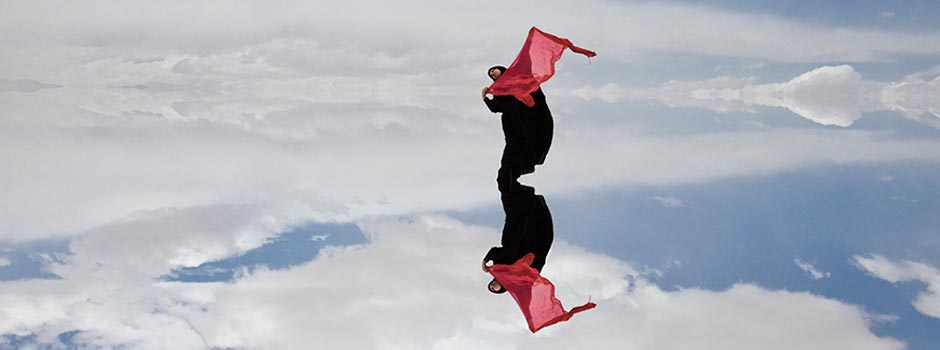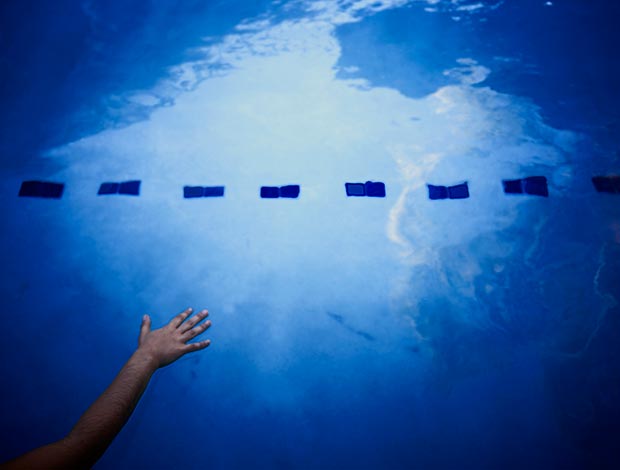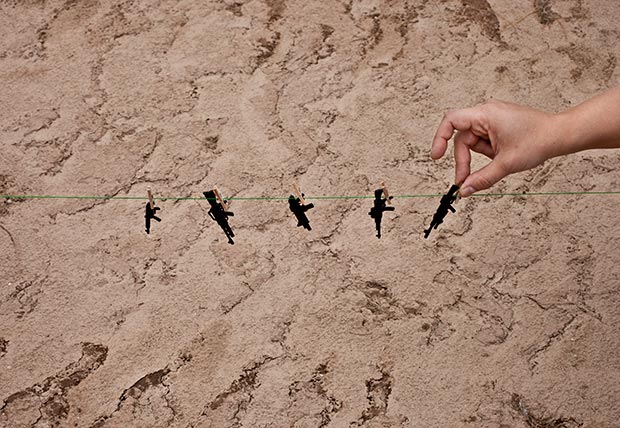
EXHIBITION AT AYYAM GALLERY, DUBAI (NOV 16, 2015 – JAN 14, 2016) Sama Alshaibi: ‘Collapse’
Oct 08, 2015 Exhibition

_Silsia-series_2011_Disec_166x250cm.jpg) Sama Alshaibi, Al-á¹¢aḥrÄʾ al-Bayá¸Äʾ (The white desert) from Silsia series, 2011, Disec, 166 x 250 cm / Courtesy of Ayyam Gallery and the Artist
Sama Alshaibi, Al-á¹¢aḥrÄʾ al-Bayá¸Äʾ (The white desert) from Silsia series, 2011, Disec, 166 x 250 cm / Courtesy of Ayyam Gallery and the Artist
The exhibition highlights Alshaibi’s conceptual approach to photography and the layered and collapsing signs that are integral to her distinctive aesthetic, particularly her use of the body as a metaphor for spatial and temporal transgressions. In addition to outlining Alshaibi’s intricate sense of formalism, the photographs, installations, and videos of 'Collapse' indicate the underlying themes that have shaped an ongoing narrative in her work, as the artist traces the consequences of war, the psychic effects of forced migration, and the ecological crises that have resulted from such manmade disasters.
Several of Alshaibi’s photo-based projects are included in the exhibition, allowing the viewer to travel through a series of performances. By positioning her body, or that of another model, as an image that measures the psychological content of a scene, Alshaibi symbolically gestures to conditions that obstruct physical movement and suspend the imagination, forcing figures to navigate the unseen yet palpable obstacles of fraught spaces.
A centerpiece of Collapse is the multimedia series 'Silsila', which was first shown as part of the Maldives pavilion of the 2013 Venice Biennale. Depicting a journey that traces the footsteps of fourteenth-century Moroccan explorer Ibn Battuta, Alshaibi composes a chain of images that link the significant desert areas and shrinking bodies of water of the MENA region to the island nation of the Maldives, which is currently threatened by rising sea levels. Also inspired by the nomadic traditions of Bedouins, Alshaibi performs at each site, alluding to the processes of purification, transcendence, and renewal while signaling the mystical and historical continuity of these diverse environments.
_Silsila-series_2014_Diasec_120cm-diam_Ed-of-3.jpg) Sama Alshaibi, Tasma‛ (Listen) from Silsila series, 2014, Diasec, 120 cm diameter, Edition of 3 / Courtesy of Ayyam Gallery and the Artist
Sama Alshaibi, Tasma‛ (Listen) from Silsila series, 2014, Diasec, 120 cm diameter, Edition of 3 / Courtesy of Ayyam Gallery and the Artist
_Silsila-series_2014_Diasec_166x250cm.jpg) Sama Alshaibi, MÄ Lam TabkÄ« (Unless weeping) from Silsila series, 2014, Diasec, 166 x 250 cm / Courtesy of Ayyam Gallery and the Artist
Sama Alshaibi, MÄ Lam TabkÄ« (Unless weeping) from Silsila series, 2014, Diasec, 166 x 250 cm / Courtesy of Ayyam Gallery and the Artist
 Sama Alshaibi, Noor, video still from the project Silsila, 2013, 6mins / Courtesy of Ayyam Gallery and the Artist
Sama Alshaibi, Noor, video still from the project Silsila, 2013, 6mins / Courtesy of Ayyam Gallery and the Artist
The title work of the exhibition is a split channel video that invokes the collapse of social structures as different forces struggle for power and humankind disregards the intensifying destruction of the environment. Narrated by the melancholic and foreboding sounds of a child’s violin, 'Collapse' (2013-14) describes the loss of our most essential source of sustenance while we remain focused on momentary dominance, collectively headed towards disaster.
 Sama Alshaibi, Collapse, 2013-14, Still from video installation / Courtesy of Ayyam Gallery and the Artist
Sama Alshaibi, Collapse, 2013-14, Still from video installation / Courtesy of Ayyam Gallery and the Artist
As a sort of epilogue to the 'Silsila series' and 'Collapse', Alshaibi’s newly created multimedia installation 'Exodus' (2015) confirms her earlier predictions of impending widespread crises. Inspired by the recent mass migration resulting from overlapping conflicts in North Africa and West Asia, the large-scale installation maps the delicate nature of human life as communities and lands are torn apart by violence. The colony collapse of honeybees that serves as a disquieting metaphor in 'Collapse' reappears in the detailed image of a bee’s magnified wings, which is realised in the form of a sculptural object. Between the mosaic veins of each wing are video images that describe the trails of refugees that are now etching new migratory patterns across the world as other environments are left burning.
 Sama Alshaibi, Sketch 3 from Negative Capable Hands series, 2007, 51 x 73.5 cm / Courtesy of Ayyam Gallery and the Artist
Sama Alshaibi, Sketch 3 from Negative Capable Hands series, 2007, 51 x 73.5 cm / Courtesy of Ayyam Gallery and the Artist
 Sama Alshaibi, Sketch 5 from Negative Capable Hands series, 2007, 51 x 73.5 cm / Courtesy of Ayyam Gallery and the Artist
Sama Alshaibi, Sketch 5 from Negative Capable Hands series, 2007, 51 x 73.5 cm / Courtesy of Ayyam Gallery and the Artist
Sama Alshaibi’s multimedia work explores spaces of conflict and the power struggles that arise in the aftermath of war and exile. Alshaibi is particularly interested in how such clashes occur between citizens and the state, creating vexing crises that impact the physical and psychic realms of the individual as resources and land, mobility, political agency, and selfaffirmation are compromised. Through performance, video, photography, and installation, Alshaibi positions her own body as an allegorical site that makes the byproducts of war visible.
Born in Basra to an Iraqi father and a Palestinian mother, Sama Alshaibi is based in the United States where she is Chair and Associate Professor of Photography and Video Art at the University of Arizona, Tucson. Alshaibi also holds a BA in Photography from Columbia College and an MFA in Photography, Video, and Media Arts from the University of Colorado. Her works are housed in both public and private collections, including the Museum of Fine Arts, Houston; Nadour, Germany; The Barjeel Collection, Sharjah; The Rami Farook Collection, Dubai; and the Museum of Modern and Contemporary Art in Tunis, Tunisia. In 2014, Alshaibi was awarded the prestigious Fulbright Scholar Fellowship as part of a residency at the Palestine Museum in Ramallah, where she developed an education program while conducting independent research.
Recently, Alshaibi has featured in solo and group exhibitions at the Pirineos Sur Festival, Lanuza, Spain (2015); Ayyam Gallery, London (2015); Arab American National Museum, Michigan (2015); Honolulu Biennial, Hawaii (2014); Photo Shanghai (2014); FotoFest, Houston (2014); the Maldives Pavilion of the Venice Biennale (2013); Venice Art Gallery, Los Angeles (2013); Madrid Palestine Film Festival (2013); University of Southampton (2013); Museum of Modern Art, New York (2012); Edge of Arabia, London (2012); HilgerBROTKunsthalle, Vienna (2012); Institut Du Monde Arabe, Paris (2012); Maraya Art Centre, Sharjah (2012); LawrieShabibi, Dubai (2011); and Selma Feriani Gallery, London (2010). Sand Rushes In, Alshaibi’s first monograph, was published by Aperture Foundation, New York in 2015.
Comments
Add a comment